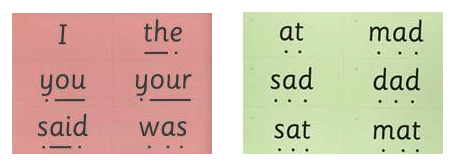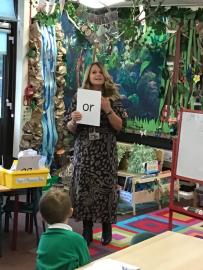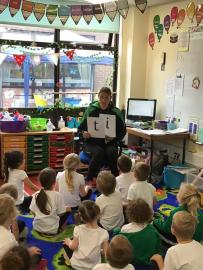At Meadowside Primary School we use the Read, Write Inc phonics scheme which begins in the early stages by teaching all of the letter sounds as pure sounds alongside showing children how to blend for reading and segment for spelling. So d-o-g will equal dog but in order to keep the sounds pure avoid stressing the letters as duh-o-guh.
As the sessions progress the children are taught combinations of two and three letters (digraphs and trigraphs also refered to as special friends) which actually produce one sound (phoneme). Further along in the scheme they learn alternative ways to spell many of the 44 phonemes in the English language. Alongside this children are taught to read and spell “red” (tricky) high frequency words which cannot be decoded at their phase of learning. The overall aim of the phonics programme is for automatic reading of all words – decodable (green words) and tricky (red words). Reception and Yr 1 children have a phonics sessions 4 times a week.
Years 1 and 2 children have booster sessions and focus more on the application of words and spelling. Parents are informed about our phonics teaching at annual information evenings.
Early Reading at Meadowside Primary School
At Meadowside Primary School we aim for all our children to become fluent, confident readers who are passionate about reading.

Children who read regularly or are read to regularly have the opportunity to open the doors to so many different worlds! More importantly, reading will give your child the tools to become independent life-long learners.
We can achieve this together through:
- Read Write Inc, a program to help to your child read at school.
- Encouraging children to develop a love of books by reading to them daily, at home and at school.
- Giving children access to a wide range of books at school and at home.
At Meadowside Primary School we use Read Write Inc Phonics (RWI) to give your child the best possible start with their English skills. We have put together a guide to how the RWI programme works together with some useful links.
Mrs Day is our Read Write Inc lead teacher, so if you have questions about RWI, please contact the school office who can refer you to her. Please take the time to read the information as it will provide invaluable information as to how you can help and support your child in reading.
What is Read Write Inc?
Read Write Inc (RWI) is a phonics complete literacy programme which helps all children learn to read fluently and at speed so they can focus on developing their skills in reading, vocabulary and spelling. The programme is designed for children aged 4-7. However, at Meadowside Primary School we begin the programme in Nursery and will continue teaching RWI to children beyond the age of 7 if they still need support in their reading.
RWI was developed by Ruth Miskin and more information on this can be found at https://ruthmiskin.com/en/find-out-more/parents/.
How will RWI be taught?
All children are assessed half termly by teachers so they work with children at the same level. This allows complete participation in lessons.
Nursery
When appropriate, children will be introduced to the initial sounds in short five minutes sessions. This will usually take place in the Spring and Summer terms before starting School.
Reception
In Reception all children will learn how to ‘read’ the sounds in words and how those sounds can be written down.
Reading
The children:
- learn 44 sounds and the corresponding letters/letter groups using simple picture prompts – see below
- learn to read words using Fred talk and sound blending
- read from a range of storybooks and non-fictions books matched to their phonic knowledge
- work well with partners
- develop comprehension skills in stories by answering 'Find It' and 'Prove It' discussion questions
Writing
The children:
- learn to write and form the letters/letter groups which represent the 44 sounds with the help of fun phrases
- learn to write words by using Fred Talk
- learn to build sentences by practising sentences out loud before they write
Talking
The children
- work in pairs so that they:
- answer every question
- practise every activity with their partner
- take turns in talking and reading to each other
- develop ambitious vocabulary
Year One & Year Two
Children follow the same format as Reception but will work on complex sounds and read books appropriate to their reading level. Daily speed sound sessions of RWI phonics lessons last for 20 minutes. Once children become fluent speedy readers children are moved onto colour banded books in Year 1 and Accelerated Reader (AR) books in Year 2.
Five key principles underpin the teaching in all Read Write Inc. sessions:
- Purpose – know the purpose of every activity and share it with the children, so they know the one thing they should be thinking about
- Participation – ensure every child participates throughout the lesson. Partnership work is fundamental to learning
- Praise – ensure children are praised for effort and learning, not ability
- Pace – teach at an effective pace and devote every moment to teaching and learning
- Passion – be passionate about teaching so children can be engaged emotionally.
Children will be taught how to read as follows:
Before you start to teach your child, practise saying the sounds below. These are the sounds we use to speak in English.
Fred Talk

We use pure sounds (‘m’ not’ muh’,’s’ not ‘suh’, etc.) so that your child will be able to blend the sounds into words more easily.
At School we use a puppet called Fred who is an expert on sounding out words! We call it, ‘Fred Talk’. E.g. m-o-p, c-a-t, m-a-n, sh-o-p, b-l-a-ck.
The following video is an example of blending sounds with Fred. https://www.youtube.com/watch?v=dEzfpod5w_Q
The children are taught the sounds in 3 sets.
Step 1:
Set 1 Sounds are taught in the following order together with rhymes to help children form the letters correctly and instantly recognise sounds ready for blending.
|
Set 1 | |
|---|---|
|
Sound |
Rhyme |
|
m |
Down Maisie then over the two mountains. Maisie, mountain, mountain. |
|
a |
Round the apple, down the leaf. |
|
s |
Slide around the snake |
|
d |
Round the dinosaur's back, up his neck and down to his feet. |
|
t |
Down the tower, across the tower, |
|
i |
Down the insects body, dot for the head. |
|
n |
Down Nobby and over the net. |
|
p |
Down the plait, up and over the pirates face. |
|
g |
Round the girls face, down her hair and give her a curl |
|
o |
All around the orange |
|
c |
Curl around the caterpillar |
|
k |
Down the kangaroos body, tail and leg |
|
u |
Down and under the umbrella, up to the top and down to the puddle |
|
b |
Down the laces, over the toe and touch the heel |
|
f |
Down the stem and draw the leaves |
|
e |
Slice into the egg, go over the top, then under the egg |
|
l |
Down the long leg |
|
h |
Down the horse's head to the hooves and over his back |
|
sh |
Slither down the snake, then down the horse's head to the hooves and over his back |
|
r |
Down the robot's back, then up and curl |
|
j |
Down his body, curl and dot |
|
v |
Down a wing, up a wing |
|
y |
Down a horn, up a horn and under the yak's head. |
|
w |
Down, up, down, up the worm. |
|
th |
Down the tower, across the tower, then down the horse’s head to the hooves and over his back |
|
z |
Zig-zag-zig, down the zip. |
|
ch |
Curl around the caterpillar, , then down the horse's head to the hooves and over his back |
|
qu |
Round the queen’s head, up to her crown, down her hair and curl |
|
x |
Cross down the arm and leg and cross the other way |
|
ng |
A thing on a string |
|
nk |
I think I stink |
Please do not use letter names at this early stage.
Click here to hear how to pronounce sounds correctly.
Children will also use pictures for each sound to help recognise the sound and then form the shape of the sound.

Step 2:
The children are then taught Set 2 Sounds - the long vowels. When they are very confident with all of set 1 and 2 they are taught Set 3 Sounds.
|
Long vowel sound |
Set 2 Speed Sound cards Teach these first |
Set 3 Speed Sound cards | |
|---|---|---|---|
|
ay |
ay: may I play |
a-e: make a cake |
ai: snail in the rain |
|
ee |
ee: what can you see |
ea: cup of tea |
e: he me we she be |
|
igh |
igh: fly high |
i-e: nice smile |
|
|
ow |
ow: blow the snow |
o-e: phone home |
ao: goat in a boat |
|
oo |
oo: poo at the zoo |
u-e: huge brute |
ew: chew the stew |
|
oo |
oo: look at a book |
||
|
ar |
ar: start the car |
||
|
or |
or: shut the door |
aw: yawn at dawn |
|
|
air |
air: that’s not fair |
are: share and care |
|
|
ir |
ir: whirl and twirl |
ur: nurse for a purse |
er: a better letter |
|
ou |
ou: shout it out |
ow: brown cow |
|
|
oy |
oy: toy for a boy |
oi: spoil the boy |
|
|
ire |
ire: fire fire! |
||
|
ear |
ear: hear with your ear |
||
|
ure |
ure: sure it’s pure? |
||
Nonsense words (Alien words)

As well as learning to read and blend real words children will have plenty of opportunities to apply their sound recognition skills on reading ‘Nonsense words’ or ‘alien words’. These words will also feature heavily in the Year One Phonics Screening check in the summer term.
Step 3:
Children will be introduced to ‘Ditty books’ when they successfully begin to read single words. The short vowels should be kept short and sharp:
Children use sound-blending (Fred Talk) to read short ditties. They will bring these home once they have read and discussed the book in class. Children will then be challenged to use their developing phonic knowledge to write short sentences.
Within all the books children will have red and green words to learn to help them to become speedy readers. Red words are words that are not easily decodable and challenge words to extend children’s vocabulary. Green words are linked to the sounds they have been learning and are easily decodable.

Dots and dashes represent the sound each letter makes.
During a RWI reading session children will read a book and have plenty of opportunities to practise using their developing comprehension skills.
Order of Story books: Children will hopefully follow the order listed below. The expectation is that all children will leave Year One as confident speedy readers, ready to take on the challenges of Year Two. However, some children may need extra support and your teacher will talk to you about this.
|
Books |
Year Group Expectations |
| Sound blending books | Reception |
|
Red Ditty Storybooks |
Reception |
|
Green Storybooks, Non-Fiction and Book Bag books |
Reception |
|
Purple Storybooks, Non-Fiction and Book Bag books |
Reception |
|
Pink Storybooks, Non-Fiction and Book Bag books |
Year One |
|
Orange Storybooks, Non-Fiction and Book Bag books |
Year One |
|
Yellow Storybooks, Non-Fiction and Book Bag books |
Year One |
|
Blue Storybooks, Non-Fiction and Book Bag books |
Year One/Year Two |
|
Grey Storybooks, Non-Fiction and Book Bag books |
Year Two |
To help at home:
Your child will start to bring books home when they are confident readers. Please help them to read and give lots of praise! It is expected that children can read their reading books fluently, this may mean reading books up to three times at home to help develop their confidence, fluency and speed when reading. Please also share other books with your children at home, visit the library and don’t forget the importance of a bedtime story.
If you have any other questions about RWI, please see your class teacher or see Mrs Day.
Phonics Screening Check Year One
What is the Year 1 phonics screening check?
The Year 1 phonics screening check is a short, light-touch assessment to confirm whether individual pupils have learnt phonic decoding to an appropriate standard.
It will identify the children who need extra help so they are given support by their school to improve their reading skills. They will then be able to retake the check so that schools can track pupils until they are able to decode.
During the Spring Term a workshop will be held for Year 1 parents to attend with extra information and some examples of the Phonics screening check.
Useful websites for Parents
Please find a list of websites that you may find useful in helping you and your child learn about phonics. Games and fun activity websites are also included.
http://www.phonicsplay.co.uk/ - many games to play
http://www.ictgames.com/literacy.html - fun games for the children to play
http://www.oxfordowl.co.uk - access a range of decodable e-books
BBC Bitesize - many games to play covering all areas of the curriculum


